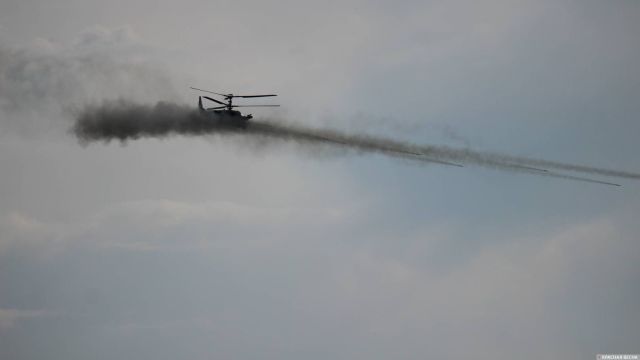The launch of missiles by a combat helicopter up a hinged trajectory resembles the operation of multiple launch rocket systems. Smoky streaks of rocket exhaust, obliquely going into the sky. The "jump" of the helicopter with the nose lifting. From the outside, many moments and details accompanying such a volley are not visible. Why and how is it done, how is it effective and what benefits does it give, what disadvantages does it contain? Naked Science decided to delve into the details.
Cabrioning: what kind of beast?
Cabring is the flight of an airplane or helicopter with a climb and a nose raised above the horizon. This word came to us from the French language and comes from the French "cabrage" (cabrage), which goes back to cabre (the raised position of the animal under the rider) or cabrer — to rear up.
And it is better to replace the words "airplane or helicopter" with "aerodynamic aircraft". It can be a glider, an autogyro, a cruise missile, from subsonic to hypersonic, or an air—to-air guided missile.
But if a near-Earth satellite is gaining altitude on the ascending part of its orbital ellipse, and its front part is raised above the plane of the local horizon, then they do not talk about cabrioning. Just as they do not talk about the maneuvering of a mortar mine rising to the highest point of its trajectory with its nose above the horizon and with a climb.
Its measure is the cab angle — the angle between the longitudinal axis of the aircraft and the plane of the horizon. This is the same as the positive pitch determined by the pitch angle — also the angle between the longitudinal axis of the aircraft and the plane of the horizon.
Why do they use cabriolet? The pilot lifts the nose of the aircraft to increase the climb or stop the descent (for example, when the aircraft is held over the runway during landing). With an increase in the pitch angle, there is usually an increase in the angle of attack, the angle of blowing the aircraft with an oncoming flow, which leads to an increase in lift. This is used when performing many aerobatics or for taking off and climbing during takeoff. In other words, cabrioning is used to control the movement of the aircraft, in order to perform the current and further elements of the flight, to ensure their desired parameters.
And there is a special case of using cabriolet, in which the angle of the nose of the aircraft above the horizon does not serve for further flight. Performed by an airplane or helicopter, such cabring serves not aerodynamics, but ballistics, a ballistic task. This is the task of the initial trajectory angle for the ballistic movement of the munition, which is separated or launched from the angle of cabrization.
Airplane methods of using weapons in the service of helicopters
Planes were the first in aviation to use unguided ammunition. The methods of their use were developed long before the advent of guided munitions. From the cabring mode, they began to throw free-fall bombs from airplanes. The detachable bomb received the initial speed at which the plane was flying, and the angle of movement relative to the horizon at which the dropped bomb was gaining altitude. Then the bomb flew along a ballistic trajectory, reaching the top point and moving after it to the descending part of the trajectory. Dropping the bomb at an upward angle increased the range of its forward flight after separation from the aircraft (this is called the bomb's attitude). Variations of such a drop also gave other advantages, for the sake of which the bombing was carried out vertically upwards, with a 90-degree pitching angle, and even a few back, with a 110-degree pitching.
In 1939, five specially equipped I-16 fighters under the command of Captain Zvonarev used unguided RS-82 rocket-fragmentation shells on enemy aircraft on Khalkhin-Gol, opening the era of this type of weapon. Later, their launch at ground targets, including from cabriolet, became a logical continuation of bombing methods. Of course, not for every launch of such rockets, cabrization was used. It was practiced when it was necessary to hit a ground target from the greatest distance and at the same time not entering the target's air defense zone. Staying in the distance, the plane, after launching the rockets at an angle well above the horizon, turned around and left, and the stretched slide performed by the shells reached the target.
Such a launch, of course, has a downside — along with the increase in range, the dispersion of launched projectiles also increases. After all, they are uncontrollable, and the main part of the flight is carried out ballistically in free fall. This means that their unadjusted elongated flight will also give an increase in the scattering ellipse when falling to the ground. Such a strike can be applied to area targets, but not to point objects. Taking into account the variety of targets and combat missions, the launch of unguided missiles from a cab has taken its place in aviation combat practice.
The armament of combat helicopters, which appeared later than airplanes, came from the aircraft field — both airborne artillery, guided missiles, bombs, and unguided rockets. The use of the latter from a helicopter also preserved the launch from a cabriolet, only it was adapted to helicopter specifics.
NAR — unguided aircraft missile
Today, unguided aircraft projectiles are called unguided aircraft missiles, or NAR. They are no longer used to defeat aerial targets, but are widely used on land. Structurally, these missiles have not undergone significant changes in more than 80 years of existence: it is a long metal tube filled with solid fuel, with a jet nozzle behind to create jet thrust. The front part of the pipe has a streamlined nose (usually the fuse is made in the shape of a cone), behind it is a warhead with an explosive charge and a body that gives a fragmentation mass when detonated. At the back of the tube there is a tail for aerodynamic stabilization in flight — either rigid or opening after launch. Bunks are equipped in a cylindrical block, a kind of barrel with numerous launch tubes. (Aircraft blocks have a pointed streamlined nose, since the flight speeds of aircraft are higher, and this shape will give less aerodynamic drag.) The unit is suspended on helicopter pylons carrying weapons. At the moment of application, the bunks start their solid-fuel engines and take turns and often fly out of the block, creating a stretched volley.
This is a metal pipe about the length of a person of average height (1428-1700 mm), 80 mm in diameter, and weighing 11-15 kg. Combat units weighing several kilograms (3.5-7.5 kg) contain 1-3 kg of explosives, usually based on hexogen or octogen, powerful high explosives with a high detonation rate. The purpose of combat units is very different: these are cumulative fragmentation, including with arrow-shaped striking elements (small steel nails with four stabilizers instead of a cap, 2 thousand pieces in a rocket). These are armor-piercing, concrete-piercing, high-explosive volumetric detonating warheads, high-explosive penetrating, tandem cumulative, lighting, jamming, marker (smoke for target designation) and others.
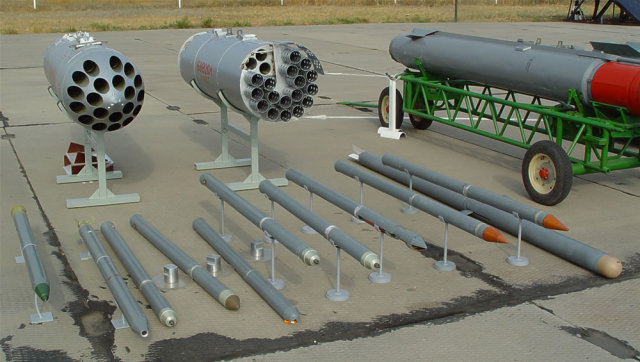
Various types of NAR S-8 and BM8 units for their launch in the background, airplane (left) and helicopter (right). Photo: voennoe-obozrenie.ru
The entire S-8 family is supersonic: the flight speed after fuel burnout is 450-700 meters per second. The launch range is 1.2-4 kilometers, the effective range is 2 km. Of course, the range needs to be specified: from what height and speed the aircraft was launched, at what angle to the horizon. Missiles are placed in B8 launch blocks of various modifications (aircraft and helicopter), for 20 and 7 missiles. The blocks are suspended on the carrier holders and remain on them after starting. After departure from the block behind the rocket, six stabilizer feathers open, the engine runs for 0.7 seconds, accelerating the rocket to operating speed. Then there is a ballistic fall on the target, like a rocket-propelled grenade, mine, bullet or projectile. When meeting with the target, the warhead is triggered, causing a striking action, for which the modification of the missile is specialized.
Helicopter specifics of the NAR application
The most effective weapon of helicopters is undoubtedly guided missiles. But bunks are also used on rotary-wing combat vehicles. The most effective use of unguided missiles is their launch at a visually observable target located in the field of view of the helicopter. Such a launch is made from a horizontal flight or a dive to a target directly observed by the pilot. This achieves a targeted launch at a point target, an object of small size, with a concentration of falling missiles on this object and in close proximity to it.
An important point should be noted here. Initially, "airplane", unguided aircraft missiles are more effective when used from an airplane. Why? The aircraft has a higher flight speed. The launch of the S-8 aircraft takes place at an aircraft speed of hundreds of meters per second — from 166 to 330, up to transonic speed. Accordingly, the rockets launched from it also get higher speed. As a result, they fly up to the target faster and due to this they are less blown away by the wind. At the same time, the plane flies steadily, without noticeable shaking and vibrations. And the launch blocks of the bunks are fixed on the aircraft coaxially with its main axis: the direction of launching missiles is highly parallel to the main, longitudinal axis of the aircraft (it is called the SGF — the construction horizontal of the fuselage). Which simplifies accurate aiming before launching by piloting the aircraft.
The conditions for launching a NAR from a helicopter are different. Here, the speed of the helicopter is only the first hundreds of kilometers per hour, which is significantly less than airplane speeds. Rockets fly to the target slower, so their wind drift is greater. Rockets are launched under conditions of vibrations and shaking, constant small angular movements of the helicopter body, which increases the spread of missile trajectories during launch and their points of fall on the ground. And the suspension of the blocks is not always aligned with the longitudinal axis of the helicopter.
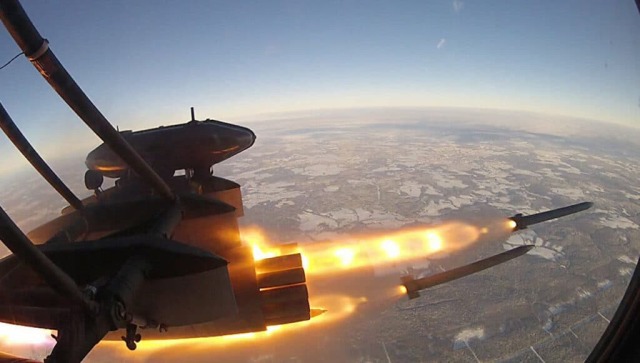
Launch of the NAR from the Mi-8 helicopter. Photo: ria.ru
Thus, the horizontal flight of the Mi-8 at cruising speeds occurs with a negative pitch of 2-3 degrees: the helicopter flies forward with its nose tilted. This occurs as a result of the creation of horizontal thrust by the main rotor — the cone of rotation of the main rotor tilts forward due to the operation of the swing mechanism of the blades. Due to the tricky mechanics of the screw skewing machine, due to the spacing of the horizontal hinges of the blades, there is a moment that tilts the nose of the helicopter down when creating horizontal thrust.
In order to perform a horizontal launch of the NAR in flight, their blocks are installed at the same angle up to the axis (SGF) of the helicopter — up by 2-3 degrees. Then, with the usual downward tilt of the helicopter, the axis of the block and the axes of the launch tubes in it occupy a horizontal position. For each type of helicopter, this angle is different. On the most modern combat helicopters, servos can be used to change the angle of installation of the NAR blocks in flight.
Situations for launching NAR helicopters from cabrioning
So, helicopter application of NAR with cabrioning increases the range and dispersion of missile drop points, not allowing you to work on a point target. Nevertheless, in a number of situations, the launch of a NAR from helicopters is optimally carried out from a cab.
The launch of the NAR from helicopters, filmed through a thermal imager. The scattering of NAR in flight and the points of explosions when falling to the ground are clearly visible
Launching on a hinged trajectory allows you to throw missiles over a vertical obstacle, which is impossible when launching with direct observation of the target (from horizontal flight or dive). A local vertical obstacle is usually a raised relief element — a hill, a hill, a small mountain ridge or a ridge, a spur of a mountain, a high bank, a fold of relief. At the same time, the obstacle plays the role of a helicopter masking element, blocking it from detection and observation by the target. Hiding behind an elevation, the helicopter launches bunks in greater safety.
When launched from a cabriolet, the rockets fly along a longer hinged trajectory. The duration of the flight and the effect of aerodynamic drag leads to the deceleration of missiles to subsonic speeds. Reducing the speed makes the descending part of the trajectory more hinged, increasing the angle of incidence (the angle of inclination of the trajectory) and resembling mortar firing.
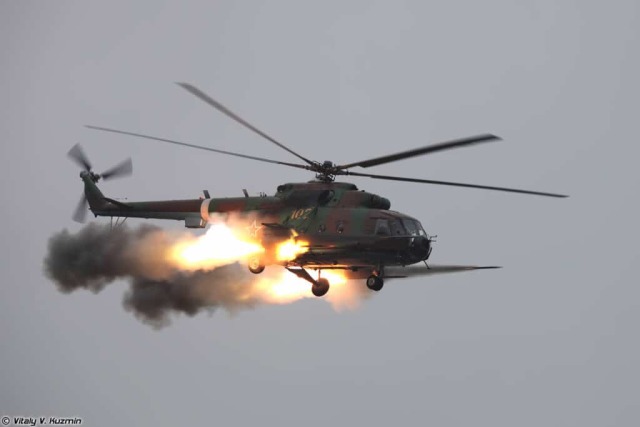
Launch of the S-8 family NAR from the Mi-8 helicopter. Photo: Vitaly Kuzmin
Such a hinged drop is effective with an abundance of trenches and trenches on the target area. And also in case of damage to equipment hidden in caponiers — high horseshoe-shaped dirt embankments surrounding a parking lot with an airplane, helicopter or other equipment. These mounds protect equipment in the parking lot from shrapnel and shock waves from bomb explosions and missile warheads outside the caponier. When launching the NAR from a distance, from a horizontal flight or a gentle dive, the target is not visible — it is covered by a caponier. And the bunks will most likely fly into the slope of the caponier without hitting the target. And with a hinged fall, the probability of hitting the parking lot from above with the defeat of equipment on it is higher.
To hit the target, you need the right combination of several flight parameters: course, distance to the target, speed, altitude and launch angle above the horizon (in the simple case of a cab angle). At the same time, the process of turning the helicopter by the cabring angle takes time and increases the flight altitude.
Therefore, the helicopter pilot must know the height and range (to the target) of entering the helicopter into the cab maneuver, as well as the required cab angle. That is, the point of entry into the cabring on the ground (in combination with the altitude of the flight), in which he must take the control handle on himself. And keep it until the required pitching angle is reached, which is usually in the range of 17-25 degrees. After that, while maintaining this angle, start up all the bunks. After the launch, the helicopter turns on the reverse course with a decrease.
At the same time, the pilot must know the tactical situation, including the height of detection of his helicopter by enemy radar stations. This is usually about 150 meters high, if we are talking about zonal air defense covering a large area with powerful long-range missiles. And the object air defense, covering a separate target object, in the form of MANPADS or short-range self-propelled anti-aircraft systems, sees a helicopter already at an altitude of 50 meters, and even less in the desert. When performing cabrioning, the helicopter should not "get out" above this height.
Piloting a helicopter while cabring: the difference with an airplane
Cabring on an airplane and a helicopter is performed differently. The pilot of the aircraft makes only one movement to switch to cabring — takes (pulls) the control handle or the steering wheel on itself and holds it in this assumed position. The plane begins to turn up its nose, continuously increasing pitch. And upon reaching the desired pitch angle (cabring angle), the pilot gives the handle away from himself to its neutral position. The aircraft remains with the resulting pitch angle and continues to climb.
For example, supersonic fighters with a triangular wing, when flying to the combat ceiling, must perform an ascent along a special high-altitude profile. At an altitude of 10 km, the aircraft was switched to horizontal mode with the ignition of the afterburner (if the afterburner had been removed before). This was done for a quick exit to supersonic mode (even faster the achievement of supersonic will be on a gentle decline from 11 to 10 km). After the aircraft went supersonic and further acceleration, the pilot took the control stick on himself, lifting his nose to an angle of about 30 degrees above the horizon. And in this position, holding the pitch angle (pitching) and the value of the Mach number of the order of 1.7 with the control knob, controlling it by the mahometer, I climbed to the ceiling in a minute. Where he put the plane into horizontal flight and accelerated to maximum speed.
The helicopter pilot continuously keeps the helicopter in a balanced state so that there are no unnecessary movements that will immediately appear with any change in flight mode. A helicopter, so to speak, is much more "gyroscopic" than an airplane. The rotor of the main rotor is a large and "powerful" gyroscope with a large moment of inertia. When trying to change the position of the main rotor axis in space, a gyroscopic moment immediately occurs, turning the axis of rotation in a different, perpendicular direction.
The reactive torque of the main rotor, which becomes uncompensated, does not "sleep" either. The result of the actions of this main pair of helicopter moments, gyroscopic and jet, can be a helicopter glide. It means that the bunks will not fly away on purpose. These rotary-gyroscopic effects are most pronounced on helicopters with a single rotor, and to a lesser extent on helicopters with coaxial screws rotating in opposite directions. Although the latter have their own peculiarities that require attention and proper working out.
Launch of the NAR with cabrioning by KA-52 and Mi-28 helicopters
How does this happen practically, in flight? To lift up the nose of the helicopter, the pilot must pull the control knob towards himself. But due to the tilt of the main rotor axis back, its gyroscopic moment will turn on, which will fill up the helicopter sideways to the left - it will give a left roll. Therefore, the pilot moves the control knob immediately and simultaneously to himself and to the right, diagonally, to compensate for the left roll that occurs when the nose is lifted.
The speed of the helicopter is set by the horizontal thrust created by the forward tilt of the rotor cone — the tilt of its lifting force. When the nose of the helicopter is lifted up, the forward tilt of the propeller decreases, the helicopter's airspeed decreases and, as a result, the thrust of the main rotor as a whole decreases. Also, due to the drop in the flow rate of the tail rotor, its thrust also decreases. This means that there is an uncompensated reactive moment of the main rotor. To parry it, the pilot must press down the right pedal with his foot ("give the right foot," as the pilots say), and with this right pedal to compensate for the reduction in the thrust of the tail rotor and prevent an unnecessary turn of the helicopter on the course. And this is only in the first moments of entering into cabring, which will be followed by no less intense piloting.
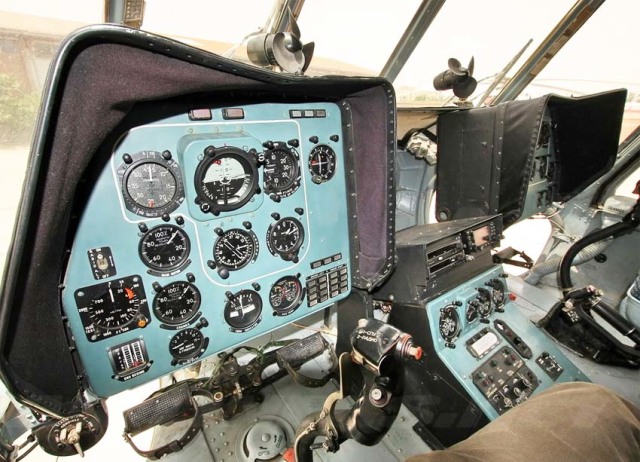
The cabin of the Mi-8MTV-5/Mi-17V-5 transport and amphibious helicopter, a modern modification of the Mi-8MT helicopter, developed taking into account the experience of combat use. Pedals and a control knob are visible, and in the center of the dashboard there is an air horizon with a ball at the bottom — a slip indicator. Photo: airwar.ru
Thus, the helicopter pilot works with several controls when performing cabring, compensating for several deviations that occur at once. At the same time, he constantly monitors the position of the ball at the bottom of the horizon, showing the helicopter gliding. The allowed slip has the most negative impact on the accuracy of the hit — the launch when sliding practically guarantees the departure of missiles past the target. Therefore, the pilot must perform the entry into the cab very clearly, precisely maintaining the required parameters throughout the entire trajectory of the helicopter, and compensating for all the "parasitic" movements that occur. At the same time, without allowing the unbalance of the complex movement of the helicopter.
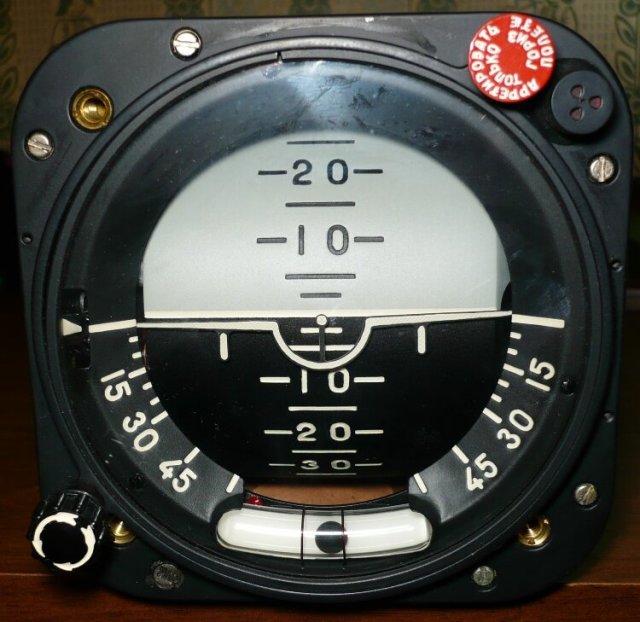
Aviagorizont AGR-29-R15. At the bottom of the gyro horizon there is a ball — a sliding indicator. Photo: vk.com
In general, for a helicopter, cabring is a more transient state compared to an airplane, where it can be a form of static flight. It is more difficult to keep the helicopter in the cabring position for a long time than an airplane, and most likely it will not work. Starting in the right way, the helicopter cabring quickly transforms into other movements, curved and uncountable. A helicopter pilot has to perform much more actions to compensate for them than an airplane pilot. Which requires the helicopter pilot to have flight experience, the correct construction of the cabring maneuver and its skillful and competent execution.
Aiming and launching the NAR when observing the target — from horizontal flight or dive
In the Soviet years, for each type of helicopter, taking into account its aerodynamics (and the aerodynamics of each type has its own unique features), tabular values of combinations of the NAR type were calculated — target range — flight speed — maneuver entry height — cab angle. Aiming took place using analog sights (Mi-8, Mi-24, Ka-27 and others). Only the commander of the aircraft aimed and fired, and the second pilot could (if experience allowed) prompt removal. Therefore, NAR shooting in those days was carried out from a steeper dive to increase accuracy.
Modern digital sighting systems work differently. Their options may act a little differently, but in general the scheme of work remains similar. The sighting complex for the NAR block consists of a round-the-clock optical system (GOES, a gyrostabilized optoelectronic system with a built-in laser rangefinder), an imaging unit and a computer. The GOES is located at the bottom of the cockpit of the helicopter "Eye of Sauron" on a gimbal, which can be fixed in the position along the axis (SGF) of the helicopter or look where it is pointed. The computer processes information from the State Power Plant, helicopter navigation systems, data on the type of NAR, and from other sources. The visualization unit displays the results of calculations on the aiming interface in the cockpit.
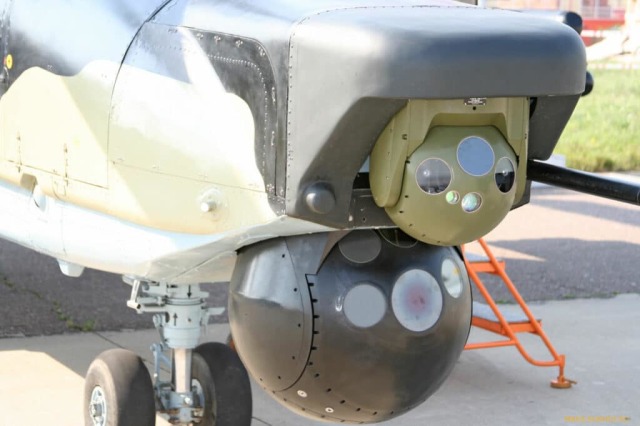
GOES in the nose of the Ka-50 helicopter. Photo: maks.sukhoi.ru
It works like this — at the time of measuring the laser range (LD) to the target, the following are recorded in the calculator with further tracking: the air and ground speeds of the helicopter, the height relative to the measured point, the inclined range to it, the course, the angles of roll and pitch. With a frequency of 1 hertz, once per second, the calculator begins to calculate corrections for shooting and generate visual commands to the visualization unit.
What does the pilot see at the same time? He sees a movable ring or a square mark on the interface. Which shows where he needs to deflect the helicopter in order to hit the selected target (to which the laser range was measured), that is, to combine a fixed crosshair with a movable mark. At the same time, the brand does not show the values of the shooting corrections, but it shows the pilot where to bring the SGF (main axis) of the helicopter to hit the target. The pilot, piloting the helicopter, causes the mark to approach the crosshair (where the SGF is located), that is, directs the SGF to the mark. After combining the brand with the crosshair (and after reaching the launch range), it is possible to launch. This aiming mode is called directorial — from the English words to direct — "direct", and direction — "direction".
How does this happen in flight? The crew knows the target location area. The helicopter's withdrawal to the launch area of the NAR will be carried out with courses other than the combat plus or minus 30 degrees. Otherwise, it will be necessary to maneuver a significant turn to the combat course, with large roll and pitch angles, which is typical for a helicopter with the development of a large slip and, as a result, the launch of the NAR is not on target. At detection and recognition ranges, the co-pilot, controlling the GOES, finds the target in the forward sector and measures the LD to the target. This completes the mission of the co-pilot. Now the commander, looking at the monitor, takes the helicopter in the direction where the circle (square) of the stamp shows. At the moment when the circle jumps on the crosshair, the commander presses the NAR start button.
Aiming and launching the NAR from the cab
But when launching from a cabriolet, the target may (and usually) not be visible, being either at a great distance with an indistinguishable dash on the horizon, or covered by an elevation of the relief. In this case, the coordinates of the target are determined in advance, before the combat departure. The geographical coordinates of the target are superimposed on the height matrix, which gives the height of this point, so the geodetic coordinates of the target are formed. They are brought into the sighting complex. Based on the current altitude, flight speed, course and coordinates of the helicopter, the calculator calculates the exit to the combat course, the beginning of the cabring maneuver and its parameters, including the cabring angle.
Next, the pilot performs the launch of the bunks in the director's office: he must clearly perform what the sighting complex calculated for him. Bring the helicopter to the starting point of the cabring maneuver with the specified parameters: altitude, course and speed. Next, perform the cabring by lifting the nose of the helicopter to the brand that will be on top. To introduce into this director's circle the axis of the helicopter and the barrels of weapons — the launch tubes of the NAR blocks. And do it without sliding, otherwise the bunks will fly off the target. And after combining the brand and the main axis of the helicopter raised above the horizon, launch the NARS. After that, exit the attack and take the helicopter away from the launch site.
The Ka-52 launches the NAR from the cabring
This is how the development of the eternal and main balance of the two basic principles of helicopter attack takes place: the effectiveness of application and safety. Today, the launch of unguided missiles from a cabriolet is used in a situation of an optimal combination of these basic factors. It is impossible to say that the launch of the NAR with cabrioning has become widespread and everyday. However, with the improvement of sighting systems, the launch from the cab is simplified for the pilot to perform, and its efficiency increases due to a more accurate and fast dynamic (according to the current flight parameters and the situation) calculation of the launch and maneuver parameters.
Therefore, the launch of missiles from a helicopter during cabring remains the method used today for the use of weapons by a combat helicopter. And pictures of such a launch periodically enter the mass information space as a clear example of this practice.
